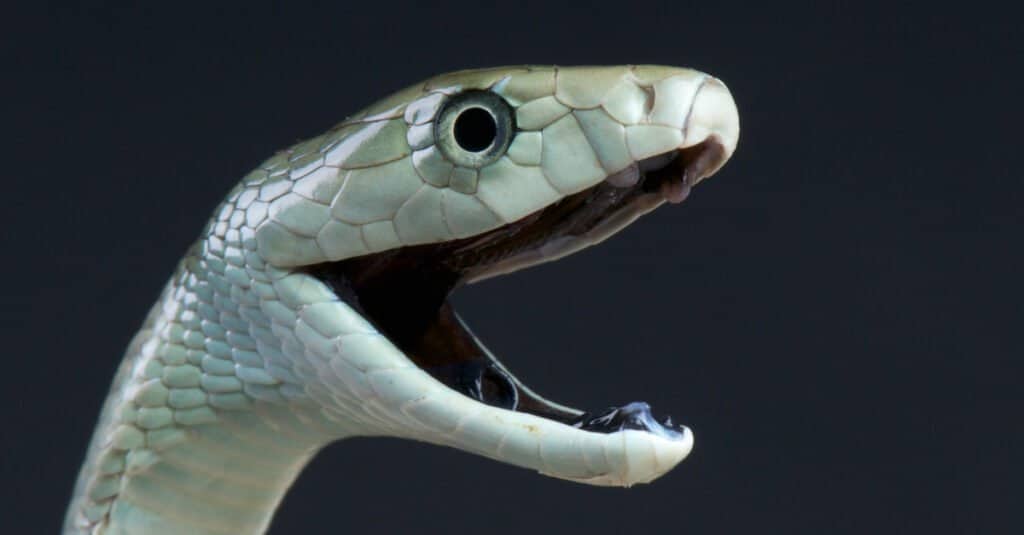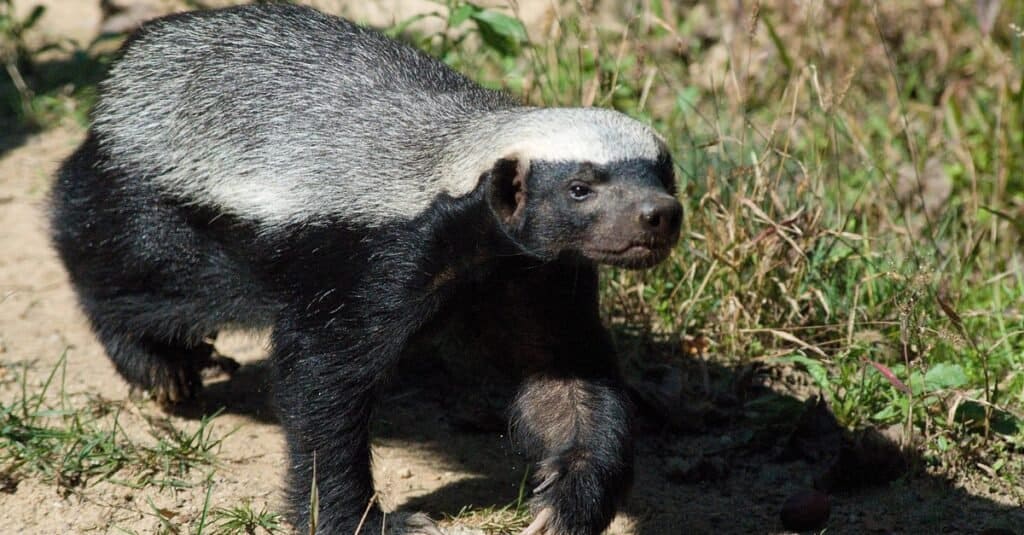The honey badger is a highly aggressive member of the Mustelidae family. Although it is a relatively small carnivorous mammal, not quite as large as most dogs, the honey badger is an incredibly deadly animal that challenges far larger animals to battle. Sharing its range in Africa is the black mamba, quite possibly the most dangerous snake alive today. When these two animals meet, who wins the fight? Today, we’re breaking down a fight between the honey badger vs black mamba to show you which of these creatures is the tougher of the two.
Comparing a Honey Badger and a Black Mamba

| Honey Badger | Black mamba | |
|---|---|---|
| Size | Weight: 11lbs to 35lbs Length: 1.5ft – 2.5ft Height: 9in-11in | Weight: 3.5-4.5lbs Length: 6ft-9.5ft, up to 14ft maximum |
| Speed and Movement Type | – 19 mph top speed | 7-20 mph |
| Unique Qualities | – Incredible agility – Very intelligent when attacking snakes – Great sense of smell – Good sense of hearing – Poor eyesight like most other Mustelids | – Powerful venom that can kill humans quickly – 100g-120g of venom per bite on average with 400g maximum – Capable of killing 10-20 humans with a single bite – 100% envenomation rate and delivers several bites |
| Defenses | – Exceptionally thick skin that resists bites, stabs, stings, and blows – Resists snake venom – Overpowering musk that can make predators flee | – A highly aggressive snake that doesn’t back down from a fight – Speed |
| Offensive Capabilities | – Sharp claws – Powerful, well-aimed bites – Can turn the tables on enemies in close quarters | – Capable of raising 40% of its body off the ground to land strikes from far away – Bites several times – Can use its length and weight to wrestle other snakes |
| Predatory Behavior | – Pursuit predators – Their teeth are sharp enough and their jaws powerful enough to bite through tortoise shells. – Digs prey out of burrows | – Ambush predator |
What Are Key Differences Between a Honey Badger and a Black Mamba?

Black mambas are deadly snakes that are accustomed to animals making way for them.
©reptiles4all/Shutterstock.com
The greatest differences between a honey badger and a black mamba include their morphology, method of attack, and size. Honey badgers are quadrupedal mammals that use their agility, teeth, and claws to kill enemies while measuring 35lbs and 11in tall, and black mambas are slithering reptiles that measure up to 14ft in length and kill their prey with deadly venom.
Knowing these differences provides valuable perspectives on the advantages that these creatures have over one another. However, this data is just a piece of the overall puzzle that we must solve to determine the fight’s winner. Let’s take a look at other factors, too.
What Are the Key Factors in a Fight Between a Honey Badger and a Black Mamba?

Honey badgers rely on their speed and fierceness to end fights in their favor.
©LM Gray/Shutterstock.com
The animals’ sizes, demeanor, and unique qualities are just a few of the most important factors we must establish to understand this fight. We’re going to look at five different dimensions of the battle between a honey badger and a black mamba. By assigning advantages to each animal in these five areas and using existing data, we’ll understand which animal wins this battle and why.
Honey Badger vs Black Mamba: Size
A honey badger is much larger than a black mamba. The average honey badger weighs up to 35lbs, grows 2.5ft long, and stands about 1ft tall. Black mambas are far longer, up to 14ft. However, they weigh about 4.5lbs at their maximum, making them far smaller than the honey badger.
Honey badgers have the size advantage in this fight.
Honey Badger vs Black Mamba: Speed
A honey badger and black mamba are just about tied for speed. High-end estimates claim that the black mamba can move at 20 mph over short distances, and the honey badger has been witnessed running at about 19 mph as it closes in on prey.
Black mambas and honey badgers are just about as fast as each other.
Honey Badger vs Black Mamba: Unique Qualities
Black mambas are some of the deadliest snakes on the planet as well as one of the most aggressive. Their venom is incredibly potent and always envenomates their prey when they bite.
Honey badgers are incredible hunters, though. They fight with intelligence, agility, and aggression. They also have finely tuned senses to help them catch prey. In particular, honey badgers have great hearing and a strong sense of smell.
The black mamba’s venom is more useful and deadlier in a fight than a honey badger’s unique qualities.
Honey Badger vs Black Mamba: Defenses
Black mambas don’t go on the defensive often. Most animals steer clear of them out of fear for their lives. Thus, their threat display and speed are their defenses.
Honey badgers have more profound defenses. Their skin is thick but loose, allowing them to absorb damage from damaging blows, bites, and stings. Furthermore, they are highly resistant to most elapid snake venom, including the black mamba.
Honey badgers have far better defenses than black mambas.
Honey Badger vs Black Mamba: Combat Skills
Black mambas are very deadly. Their venom will kill creatures many times larger than them, so most animals rightfully fear this snake. The black mamba is known for being able to lift upwards of 40% of its body off the ground before striking. That means it can bite the head and neck of most animals it comes across, allowing its venom to work even faster. Also, these snakes don’t issue dry bites; they’re always looking to kill their foes.
Honey badgers use their size and tenacity to dominate their foes. They look for an opening, shoot in, and then go in for the kill. These mammals will claw their prey to soften them up before delivering a deadly bite with their sharp teeth and strong jaws.
Both animals are highly effective fighters.
Who Would Win in a Fight Between a Honey Badger and a Black Mamba?

Honey badgers are some of the toughest animals on the planet for their size.
©Pavel Kovaricek/Shutterstock.com
A honey badger would beat a black mamba in a fight. Honey badgers are agile and capable of avoiding the black mamba’s attacks. When the fight starts, both animals will look to land killing blows. They’re highly aggressive.
The honey badger will dance around the snake, smacking it with its paws and launching feints. All the honey badger requires is one misstep by the snake so it can take off the mamba’s head.
This outcome should not be that surprising. After all, honey badgers are one of the few predators that specifically seek out venomous snakes for food. That doesn’t mean the honey badger shouldn’t be careful. While they may not die from a black mamba bite, they will often lose consciousness for minutes after envenomation. Their prey may sneak away or bite again.
Thus, the honey badger must finish the black mamba before succumbing to the venom for a short time. If local stories are to be believed, the honey badger regularly comes out of its daze and finishes off the black mamba. After all, the snake is probably used to most things dying from a single bite instead of coming back to life and attacking.
The saying “honey badger don’t care,” would hold true, and that should be even more evident now. This mammal can kill the most dangerous snake in the world outright or after learning a lesson from being envenomated.
What Kind of Animal Would Win a Fight with a Honey Badger?
While we know how tough and tenacious a honey badger is, there are other animals that could beat them in a fight. As we’ve written in another article, a lion would take down a honey badger in a duel. If they were to square off these beasts, they would most likely see each other somewhere in sub-Saharan Africa. This would probably happen in the continent’s eastern portion because they both live in the wild.
Despite its ferocity, the honey badger would not stand up to a lion in a fair fight. Lions are too strong and too powerful. Their ability to land a powerful claw swipe or, even worse, a bone-crushing bite would be more than the weasel’s smaller body could handle. Even if the sharp teeth and claws of a lion did not penetrate a honey badger’s thick, leathery skin, the blunt force of either type of assault would break bones and damage internal organs.
The photo featured at the top of this post is © Erwin Niemand/Shutterstock.com
Thank you for reading! Have some feedback for us? Contact the AZ Animals editorial team.






